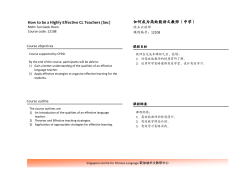
Document 432627
1. Suppose a hot air balloon is rising vertically upward, and it is tracked by a scout standing 500 ft apart from the liftoff point. At the moment the scout’s elevation angle is π/4, the angle is increasing at the rate of 0.14 rad/min. How fast is the balloon rising at that moment? Let y be the distance of the balloon from the ground and θ be the elevation angle of the scout, then y = 500 tan θ. dy dθ Differentiating with respect to t, = 500 sec2 θ . dt dt √ dy dθ 2 π At the moment concerned, the rate of change of y is = 500 sec · = 500( 2)2 · 0.14 = 140. dt 4 dt π π θ= 4 θ= 4 The balloon is rising at a rate of 140 ft/min at that moment. 2. A spotlight on the ground shines on a wall 12 m away. If a man 2 m tall walks from the spotlight toward the building at a speed of 1.6 m/s, how fast is the length of his shadow on the building decreasing when he is 4 m from the building? Let L be the length of the shadow of the man on the wall, x be the distance of the man from the spotlight. By considering similar triangles, L 2 = 12 x 24 . L= x dL −24 dx = 2 · . dt x dt When the man is 4 m from the building, he is 8 m from the spotlight, so the rate of change of L is 3 24 dx 24 8 dL = − · =− · =− . dt x=8 82 dt x=8 64 5 5 3 The length of his shadow is decreasing at m/s. 5 Differentiating with respect to t, 3. A 13-ft ladder is leaning against a wall when its base starts to slide away. By the time the base is 12 ft from the wall, the base is moving at the rate of 5 ft/sec. (a) How fast is the top of the ladder sliding down the wall? Let x√be the distance √ of the base of the ladder from the wall, y be the height of the top of the ladder, then y = 132 − x2 = 169 − x2 . dy 1 −x dx dx Differentiating with respect to t, = √ (−2x) · =√ · . dt dt 2 169 − x2 169 − x2 dt dy −12 dx −12 At this moment, the rate of change of y is =√ · = · 5 = −12. 2 dt dt 5 169 − 12 x=12 x=12 The top of the ladder is sliding down at 12 ft/sec. (b) At what rate is the area of the triangle formed by the ladder, wall, and the ground changing? 1 xy. 2 1 dy dx dA Differentiating with respect to t, = x +y . dt 2 dt dt At this the rate moment, of change of A is dA dy 119 1 dx 1 (12) . = + 5 = (12(−12) + 5(5)) = − dt x=12 2 dt x=12 dt x=12 2 2 119 2 119 2 The area is changing at − ft /sec. (Or decreasing at ft /sec) 2 2 The are of the triangle is A = 1 (c) At what rate is the acute angle θ between the ladder and the ground changing? x y y . Or sin−1 , tan−1 13 13 x dθ 1 dx −1 Differentiating with respect to t, · =p · . x 2 dt 1 − ( 13 ) 13 dt dθ −1 1 dx 13 1 q At this moment, the rate of change of θ is = · =− · · · 5 = −1. dt x=12 dt x=12 5 13 2 13 1 − ( 12 ) 13 The angle θ is cos−1 The angle θ is changing at −1 rad/sec. (Or decreasing at 1 rad/sec) 4. The minute hand on a watch is 8 mm long and the hour hand is 4 mm long. How fast is the distance between the tips of the hands changing at one o’clock? (Recall the law of cosines c2 = a2 + b2 − 2ab cos γ) Let L be the distance between the two tips, θ be the angle between the two hands. p √ √ By the law of cosine, L = 82 + 42 − 2(4)(8) cos θ = 80 − 64 cos θ = 4 5 − 4 cos θ. 2π π At one o’clock, θ = = . 12 6 The minute hand rotates clockwise in a uniform angular speed that rotates a circle in 602 seconds, the angle θ decreases as the minute hand rotates clockwise. At the same time, the hour hand rotates clockwise in a uniform angular speed a circle in (12 · 602 ) seconds, where the angle θ increases as the hour hand rotates clockwise, so 2π 2π −11π dθ =− 2 + = (measured in rad/s). 2 dt 60 12 · 60 21600 4 dθ 8 sin θ dθ dL = √ · (4 sin θ) · =√ · . Differentiating with respect to t, dt dt 2 5 − 4 cos θ 5 − 4 cos θ dt At one o’clock, 8 sin π6 8( 12 ) dL −11π −11π 11π q p =p · = = · √ . √ π dt 21600 5 − 4 cos 6 21600 5400 5 − 2 3 5 − 4( 23 ) The distance between the tips is decreasing at 11π p √ mm/s. 5400 5 − 2 3 5. Let f (x) = tan−1 x + tan−1 x1 . (a) Identify the domain of f . f is defined when x 6= 0. The domain of f is (−∞, 0) ∪ (0, ∞). (b) Show that tan−1 x is an odd function. Let u = tan−1 (−x), then tan u = −x − tan u = x tan(−u) = x −u = tan−1 x u = − tan−1 x. Since tan−1 (−x) = − tan−1 x for any arbitrary x, tan−1 x is an odd function. (c) Show that f is an odd function. −1 f (−x) = tan (−x) + tan −1 1 −x = − tan−1 x − tan−1 2 1 = −f (x), therefore f (x) is an odd function. x (d) Find f (x) for each x in the domain of f . If x > 0, let u = tan−1 x, then tan u = x. Consider a right angled triangle with an angle u, where the opposite side has length x and adjacent side has length 1. π 1 1 The other angle is v = − u, which satisfies tan v = , that is, v = tan−1 . 2 x x π −1 −1 1 Therefore f (x) = tan x + tan =u+v = . x 2 π If x < 0, then −x > 0. Since f is odd, f (x) = f [−(−x)] = −f (−x) = − . 2 ( π , x>0 Combining, f (x) = 2 π . −2, x < 0 6. Let f (x) = ex − e−x , it is known that f is a one-to-one function. 2 (a) Find f (ln 2). 2 − 12 eln 2 − e− ln 2 3 = = . 2 2 4 3 1 (b) Find (f −1 )0 ( ), by (f −1 )0 (x) = 0 −1 . 4 f [f (x)] f (ln 2) = 2+ ex + e−x eln 2 + e− ln 2 and f 0 (ln 2) = = 2 2 2 1 1 4 −1 0 3 (f ) ( ) = 0 −1 3 = 0 = . 4 f (ln 2) 5 f [f ( 4 )] f 0 (x) = 1 2 = 5 . 4 (c) Find f −1 (x). Let y = ex − e−x , then 2 2y = ex − e−x 2yex = e2x − 1 e2x − 2yex − 1 = 0. Regarding this equation as a quadratic equation in ex , by the quadratic formula, p 2y ± 4y 2 + 4 x e = p2 = y ± y 2 + 1. Since p y2 + 1 > p y 2 = |y|, y − Therefore f −1 (x) = ln(x + √ p y 2 + 1 < y − |y| ≤ 0, while ex > 0, we reject the root y − p ex = y + y 2 + 1 p x = ln(y + y 2 + 1). x2 + 1). 3 p y 2 + 1. Now (d) Differentiate the function obtained in (c) to verifty the result in (b). 1 √ · x + x2 + 1 1 3 = (f −1 )0 ( ) = q 4 ( 34 )2 + 1 (f −1 )0 (x) = 2x 1+ √ 2 x2 + 1 = √ 1 2 x2 + 1 + 2x √ √ =√ . 2(x + x2 + 1) x2 + 1 x2 + 1 4 . 5 7. Find the values of a such that the two curves y = ax and y = x are tangent to each other. Suppose that y = ax and y = x are tangent at x = p. Then the two function ax and x have the same value and same derivative at x = p. ax and x have the same value at p implies ap = p. ax and x have the same derivative at p implies ap ln a = 1. ( Now we have the two equations in two unknowns a and p: From the first equation, p ln a = ln p, so ln a = ap =p . p a ln a = 1 ln p . p ln p ln p into the second equation, we have p · = 1, which solves p = e. p p Hence from the first equation, Put ap = p and ln a = ae = e e ln a = 1 1 ln a = e a = e1/e . 4
© Copyright 2025









